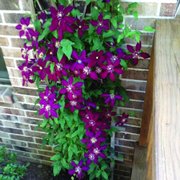Q I want to send moon-flower seeds to our daughter in Florida, but my moonflower does not produce any seed pods whatsoever. What advice can you offer me?
A There are two plants commonly called moonflower and both set seeds. Moonflower datura is the large white flower that is formed on a bush-like plant. It dies to the ground each winter and reappears from the root system, but most flowers will form a seed pod. It is a small, round seed pod covered in spikes. They start out green, then ripen to brown. Once ripe, the pods naturally split open, releasing the seeds. As soon as you see them turning brown, you can harvest seeds to send to your daughter. The other moonflower is a vining annual morning glory. It will set a small, rounded seed capsule that contains five or six seeds. Again, the pods must be fully mature for the seeds to be viable. Not every flower from either plant will set seeds, but if you have many blooms, you should see seed pods.
Q I visited my parents yesterday and my 83-year-old father had found an okra-looking seed pod that he wanted me to look at, as he knows I'm interested in plants. I asked him what kind of plant he found it on, and he said it was lying on the ground next to some vines. It looks similar to the pod from butterfly weed and milkweed species, or okra, but it has large ridges in it. What do you think the pod is from?
A My guess would be a seed pod from a pipe vine or Dutchman pipe vine. They produce almost an egg-shaped pod with deep ridges. The inside of each ridge is loaded with flat seeds. Amazing that there would be that many seeds from one seed pod.
Q I was wondering if you could give me any tips on how to get my ginger plants to bloom. I have quite a few, and they do great outside in the summer. I move them in every fall and treat them as houseplants over winter -- they do just fine. They have such gorgeous blooms when I buy them, but after that, none, not ever, and I've had some of them for four or five years.
A Do you know what type of ginger you are growing? Most members of the Hedychium genus are winter hardy throughout central and southern Arkansas, with a bit of added protection needed in the northern tier. Just mulch a bit more after a killing frost. The hardiest and most common one in this genus is the white butterfly ginger, but there are some lovely orange- and yellow-blooming varieties as well. If you are growing these they do best with full sun to partial shade. If they are in deep shade, they will not bloom. They are just now beginning to bloom and should do so for at least six weeks. Other species of ginger include the peacock (Kaempferia), which may overwinter in south Arkansas in the shade, and the torch gingers (Etlingera) and Alpinia (Shell ginger). The latter two are not winter hardy in Arkansas and would need to be moved indoors for the winter.
Q My wife was talking about moving this clematis because it was only producing a few blooms for several years. I read your article Nov. 21 and pruned it, leaving three vines -- one pruned almost to the ground, one knee-high and one I let grow. The attached picture was taken May 16. I couldn't believe all the blooms. Thanks a million. I was going to prune it after blooming, but when I finally found your article ... I saw that I must have pruned it sometime after that date. I haven't pruned it and was wondering now when to prune it. Should I wait immediately after blooming next year or prune it now? It finished blooming several weeks back.
A There are hundreds of varieties of clematis, but they typically are divided into three categories -- Group 1 comprises vines that bloom only in the spring. For those, the flower buds are set or are setting now on the old wood, and so no pruning is done now. Any pruning that is needed should be done immediately after bloom in the spring. Group 2 is made up of varieties that have two sets of blooms -- one in the spring and then one in late summer, which means they have blooms that set on the old wood like Group 1, but then they also set blooms on the new growth like Group 3. If they need pruning, remove weaker shoots immediately after bloom in the spring to encourage new growth that will then bloom later in the summer. Group 3 is what you are growing -- they bloom on the new growth in late summer. Some gardeners shear them hard and keep the vines more contained, but I like a larger vine, so I stagger the cuts. Get it through the winter, and then prune it in late February before new growth begins. By cutting out all that woody legginess, you encourage more new vines, and thus more flowers.
Janet B. Carson is a horticulture specialist for the University of Arkansas Cooperative Extension Service. Write to her at 2301 S. University Ave., Little Rock, Ark. 72204 or email her at
jcarson@arkansasonline.com
HomeStyle on 08/20/2016

